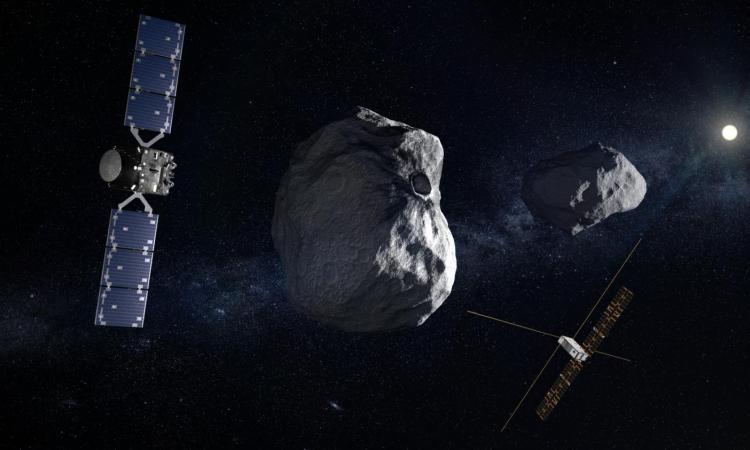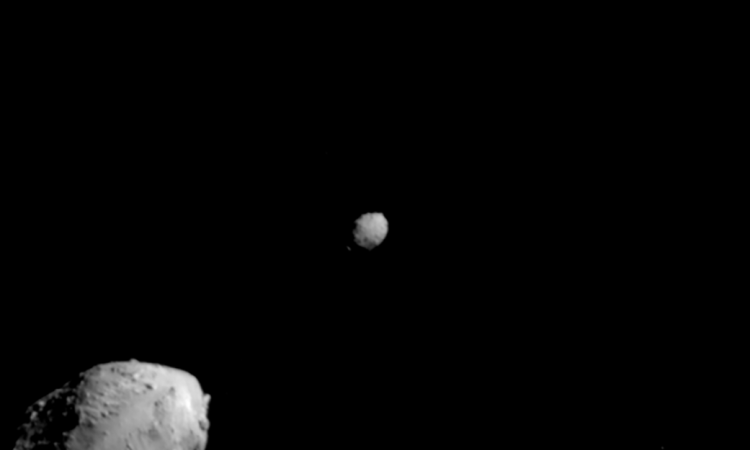A Georgia Tech study analyzes NASA’s DART mission and proposes an innovative approach for kinetic deflection.
Small rocks and debris fly near Earth, many just passing by. Some, however, come too close to Earth, with a potential threat of collision. Defending Earth from these unwanted objects is a growing concern globally. Planetary defense explores threat characterization, risk mitigation, and policy to defend Earth. One mitigation approach is sending an impactor to collide with the target object to deflect its trajectory from the original course toward Earth. This approach, known as kinetic deflection, is practical for intruders with a diameter up to a few hundred meters.
NASA’s Double Asteroid Redirection Test (DART), led by Johns Hopkins University’s Applied Physics Laboratory, was the first full-scale kinetic deflection mission to test how kinetic deflection could effectively push an asteroid measuring 150 meters in diameter. The 580-kg spacecraft (impactor) collided with the target asteroid, Dimorphos, at a speed of 6.1 km/second on September 26, 2022, making the target’s speed 2.7 mm/s. This speed change could gradually make the course deviate from the original one. The more time that elapses after impact, the further it moves away from the Earth. Even though Dimorphos was not a threat before the impact, it was chosen as a test target for DART’s kinetic deflection test.
Georgia Tech Professor Masatoshi Hirabayashi’s critical contribution to DART was recently published in Nature Communications. The study, “Elliptical ejecta of asteroid Dimorphos is due to its surface curvature” analyzed the behavior of fragments coming out by the high-speed DART impact and their push of the asteroid. This work was in collaboration with Professor Fabio Ferrari from Politecnico di Milano, who jointly published the study, “Morphology of ejecta features from the impact on asteroid Dimorphos.”
Imagine a cannonball flying through the air and hitting a concrete wall. The wall shutters and fragmented pieces disperse at high speeds. Those smaller fragments, called ejecta, are known to be a key factor in controlling the asteroid push.
The study found that the ejecta from the impact site on Dimorphos highly depends on the asteroid’s shape. As a rule of thumb, a cannonball hitting a flat concrete wall creates ejecta departing from the wall at an angle of about 45 degrees from the wall’s surface. The cloud of ejecta thus looks like a waffle cone. However, if the concrete wall’s surface is tilted against the impact direction, the fragment ejection changes, making the ejecta structure differ even if the impactor has the same mass and speed.
“This changes the asteroid push dramatically. Dimorphos has a squashed round shape, like an M&M,” Hirabayashi explained, “If the impact is large, more ejecta fly out of the surface but are more affected by surface tilts. This process makes the ejecta deviate from the ideal direction, reducing the asteroid push.”
For the DART impact on Dimorphos, the study identified the impact scale and the asteroid’s rounded surface lowered the asteroid push by 56% compared to when Dimorphos was tested as an entirely flat wall. Thus, sending a large impactor does not mean a big push, and considering how to send impactors strategically is necessary. One way to keep the asteroid push effective is to send multiple small impactors rather than a single large impactor. This way, each small impactor may avoid the target’s rounded shape, and the net asteroid push by multiple impacts can be more efficient than the single impactor.
“Sending multiple smaller impactors not only results in a higher asteroid push but also potentially saves operational cost and increases tactical flexibility for deflection.”
Masatoshi Hirabayashi
Ferrari’s study offered crucial information for Hirabayashi’s conclusions. “We used Hubble Space Telescope’s images and numerical simulations to quantify a viable mechanism of the ejecta evolution and successfully estimated ejected particles’ mass, velocity, and size. We also found complex interactions of such particles with the asteroid system and solar radiation pressure, i.e., sunlight pushing ejecta particles,” Ferrari said. “Documenting how ejecta looks over time offers crucial insights into how the DART impact acted on ejecta, giving tight constraints on the target asteroid’s properties.”
NASA’s DART mission was a success, and Hirabayashi’s study discovered an innovative approach to kinetic deflection, offering new potential for its future demonstration in space. He is building a new capability of characterizing a target’s properties beneficial for planetary defense, such as mass, size, composition, etc., at limited observational conditions. This is aligned with the fast reconnaissance concept, a new community effort that develops planetary defense strategies to identify these properties within a limited time and resources. This work continues to evolve Georgia Tech into a key player in planetary defense, connecting international communities.
Related Stories:

Hirabayashi Chosen by NASA to Join European Space Agency’s Planetary Mission to Study Results of Asteroid Deflection
Masatoshi (Toshi) Hirabayashi, an associate professor in the Daniel Guggenheim School of Aerospace Engineering, has been selected by NASA’s Hera Participating Scientist Program (HERA-PSP) to join the European Space Agency’s (ESA) Hera mission. Together, with an international consortium of 11 other scientists, Hirabayashi will perform a multi-faceted, detailed, post-impact study of NASA’s Double Asteroid Redirection Test (DART) mission. The DART mission was led by the Johns Hopkins University’s Applied Physics Laboratory.
(Photo: Conceptual graphic showing ESA’s Hera spacecraft and its CubeSats in orbit around the Dimorphos moonlet. Photo courtesy of European Space Agency (ESA) Science Office.)

AE’s Third Space Imaging Workshop Creates Hub for Imaging Experts
Seeing is believing. Imaging research allows us to observe the wonders of space from the comforts of our homes. Artemis I is about a week into its mission after launching on November 16, and has already captured images of the moon.
Top optical navigation and space imaging experts gathered at Georgia Tech’s Global Learning Center for the Third Space Imaging Workshop. The workshop focuses on the many ways that images can be used for space applications, such as landing spacecraft in dangerous locations. Presentations and interactive discussions highlighted optical navigation, planetary mapping, space domain awareness, computer vision algorithms, and much more.
(Photo: One of DART’s final images of asteroid Dimorphos prior to impact. Credits: NASA/Johns Hopkins APL)
